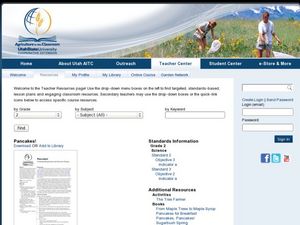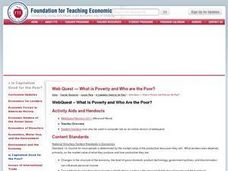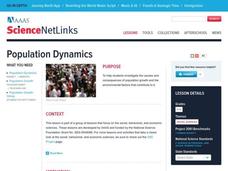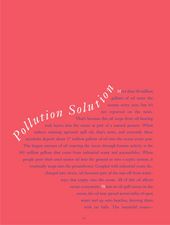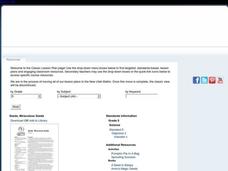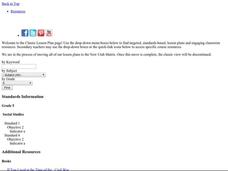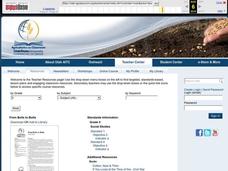Curated OER
Sars
Students discuss the Sars outbreak in 2003. In this biology lesson plan, students research the effect of the outbreak to the world. They create a public announcement about the topic.
Curated OER
Pancakes!
Second graders explore dietary habits by completing a cooking activity in class. In this breakfast preparation lesson, 2nd graders read several books about pancakes and maple syrup. Students utilize a wheat kit to understand the...
Curated OER
Bird Buffet
Fifth graders study traits of different bird beaks. In this bird lesson, 5th graders explore the function and usefulness of different inherited traits of birds.
Curated OER
Vermicomposting
Fifth graders explore agriculture by viewing compost related presentations. In this worm and soil instructional activity, 5th graders identify the relationship between good soil and the worms who inhabit it by reading assigned text in...
Curated OER
Ancient Mediterranean Lands: A Timeline of Mediterranean Civilizations
Sixth graders explore world history by participating in a class agriculture activity. In this wheat weaving lesson, 6th graders identify the different Mediterranean regions that adopted early agriculture methods and expanded their...
Curated OER
Breads Around the World
Sixth graders explore world cultures by researching dietary habits. In this bread identification lesson, 6th graders explore different regions around the world and the types of breads they produce. Students read assigned text about the...
Curated OER
Loco for Cocoa
Sixth graders explore agriculture by viewing food related videos in class. In this chocolate identification instructional activity, 6th graders discuss the healthy aspects of pure cocoa and the history of the plant. Students read...
Curated OER
Folding Our Way to Productivity
Students role-play workers producing origami cups. They participate in two production rounds, one without training and one with training. They observe how productivity increases through training and, as a result, how income increases.
Curated OER
The Nutritional Content of Food
High schoolers are given three unknown samples and must perform two chemical tests in order to determine if the samples contains protein and/or starch. Students work with corrosive or toxic reagents.
Curated OER
WebQuest- What is Poverty and Who Are the Poor?
Students are introduced to a variety of easily accessible data about poverty. The search activity performs double-duty in exposing students to the nature and magnitude of world poverty and in confronting them with different types and...
Michigan Sea Grant
Fish Habitat and Humans
Strict habitat requirements are needed for the survival of fish populations and fish variety in the Great Lakes. Young scientists become experts in the basic needs of fish and understand how survival necessities can vary with different...
Curated OER
Exploring Indiana's Natural Resources
Fourth graders complete a variety of activities as they study the European exploration of the Midwest, focusing on Indiana. They map the path explorers took, comparing the British with the French. They research why the explorers stopped...
Curated OER
Population Dynamics
Students investigate the causes and consequences of population growth and the envrionmental factors that contribute to it. They discuss what they think the world's population will be in 2050.
Curated OER
Pollution Solution!
Students listen to the story "Clean Air, Dirty Air" by Lynne Patchett and discover the main types of pollution and how these affect their bodies. In this pollution lesson, students work in small groups to create a machine to prevent...
Curated OER
Bullying
Students recognize and respond appropriate to bullying, teasing, and aggressive behaviors. In this bullying lesson plan, students listen to stories about bullying, participate in bullying discussions, and role play various scenarios to...
Curated OER
Cost Effective Egg Drop
Learners create cost effective ways to protect an egg. For this cost conscious lesson plan, students complete an egg drop activity while spending the least amount of money possible.
Curated OER
Peanut Butter Broccoli
Fifth graders explore food production by viewing DNA presentations. In this genetic engineering instructional activity, 5th graders discuss the foods they typically eat at home and how many common foods are engineered in a way that can...
Curated OER
Seeds, Miraculous Seeds
Students investigate the growth of seeds. In this agricultural lesson, students dissect a bean and corn seed and identify the parts of the seed. Students observe the development of a pinto bean seed and record observations on the...
Curated OER
Specialized Structures and Environments
Fifth graders explore biology by completing an Internet activity in class. In this adaptation lesson, 5th graders identify several organisms and mammals that fight for their existence through slow changes to their anatomy over the course...
Curated OER
Clothesline Sleuth
Fifth graders investigate the effect of North American colonization on human history. In this colonization lesson plan, 5th graders explore the global impact of colonization of North America. Students investigate the impact of geography...
Curated OER
From Bolls to Bolts
Fifth graders explore the economic effects of the colonization of North America. In this Social Studies lesson plan, 5th graders examine the economic and cultural results that occurred due to North America entering the market....
Curated OER
Label Language
Sixth graders explore healthy eating habits by identifying food labels. In this food ingredient instructional activity, 6th graders discuss the nutritional facts that are available on almost all foods in America and which ingredients and...
Curated OER
Clothesline Sleuth
Sixth graders investigate the origins of clothing production. In this Social Studies lesson, 6th graders examine the components of agriculture involved in making clothes. Students research cotton.
Curated OER
Open Wide and Meet Your Tonsils
Young scholars research their tonsils in this lesson. They research and discover what tonsils are, what they do, and where they are located. Students also identify other parts of the mouth, what they do, and where they're located. They...



